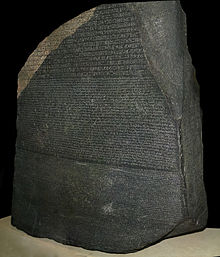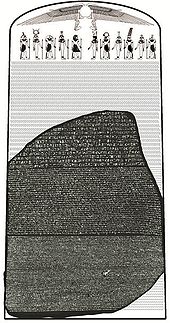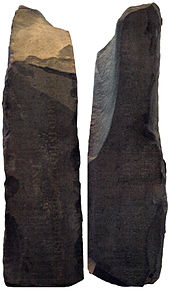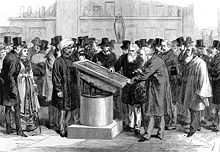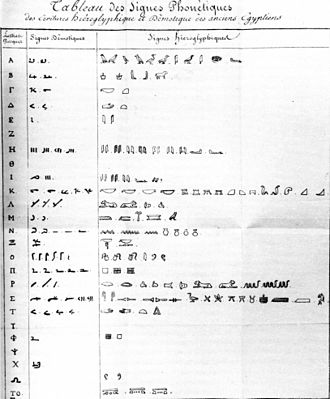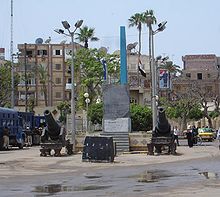- Rosetta Stone
-
For other uses, see Rosetta Stone (disambiguation).The Rosetta Stone in the British Museum

The Rosetta Stone is an ancient Egyptian granodiorite stele inscribed with a decree issued at Memphis in 196 BC on behalf of King Ptolemy V. The decree appears in three scripts: the upper text is Ancient Egyptian hieroglyphs, the middle portion Demotic script, and the lowest Ancient Greek. Because it presents essentially the same text in all three scripts (with some minor differences between them), it provided the key to the modern understanding of Egyptian hieroglyphs.
Originally displayed within a temple, the stele was probably moved during the early Christian or medieval period and eventually used as building material in the construction of Fort Julien near the town of Rashid (Rosetta) in the Nile Delta. It was rediscovered there in 1799 by a soldier, Pierre-Francois Bouchard, of the French expedition to Egypt. As the first ancient bilingual text recovered in modern times, the Rosetta Stone aroused widespread public interest with its potential to decipher the hitherto untranslated Ancient Egyptian language. Lithographic copies and plaster casts began circulating amongst European museums and scholars. Meanwhile, British troops defeated the French in Egypt in 1801, and the original stone came into British possession under the Capitulation of Alexandria. Transported to London, it has been on public display at the British Museum since 1802. It is the most-visited object in the British Museum.
Ever since its rediscovery, the stone has been the focus of nationalist rivalries, including its transfer from French to British possession during the Napoleonic Wars, a long-running dispute over the relative value of Young's and Champollion's contributions to the decipherment, and since 2003, demands for the stone's return to Egypt.
Study of the decree was already under way as the first full translation of the Greek text appeared in 1803. It was 20 years, however, before the decipherment of the Egyptian texts was announced by Jean-François Champollion in Paris in 1822; it took longer still before scholars were able to read other Ancient Egyptian inscriptions and literature confidently. Major advances in the decoding were: recognition that the stone offered three versions of the same text (1799); that the demotic text used phonetic characters to spell foreign names (1802); that the hieroglyphic text did so as well, and had pervasive similarities to the demotic (Thomas Young, 1814); and that, in addition to being used for foreign names, phonetic characters were also used to spell native Egyptian words (Champollion, 1822–1824).
Two other fragmentary copies of the same decree were discovered later, and several similar Egyptian bilingual or trilingual inscriptions are now known, including two slightly earlier Ptolemaic decrees (the Decree of Canopus in 238 BC, and the Memphis decree of Ptolemy IV, ca. 218 BC). The Rosetta Stone is therefore no longer unique, but it was the essential key to modern understanding of Ancient Egyptian literature and civilization. The term Rosetta Stone is now used in other contexts as the name for the essential clue to a new field of knowledge.
Contents
Description
The Rosetta Stone is listed as "a stone of black granite, bearing three inscriptions ... found at Rosetta", in a contemporary catalogue of the artifacts discovered by the French expedition and surrendered to British troops in 1801.[1] At some period after its arrival in London, the inscriptions on the stone were coloured in white chalk to make them more legible, and the remaining surface was covered with a layer of carnauba wax designed to protect the Rosetta Stone from visitors' fingers.[2] This gave a dark colour to the stone that led to its mistaken identification as black basalt.[3] These additions were removed when the stone was cleaned in 1999, revealing the original dark grey tint of the rock, the sparkle of its crystalline structure, and a pink vein running across the top left corner.[4] Comparisons with the Klemm collection of Egyptian rock samples showed a close resemblance to rock from a small granodiorite quarry at Gebel Tingar on the west bank of the Nile, west of Elephantine in the region of Aswan; the pink vein is typical of granodiorite from this region.[5]
The Rosetta Stone is now 114.4 centimetres (45 in) high at its highest point, 72.3 cm (28.5 in) wide, and 27.9 cm (11 in) thick. It weighs approximately 760 kilograms (1,700 lb).[6] It bears three inscriptions: the top register in Ancient Egyptian hieroglyphs, the second in the Egyptian demotic script, and the third in Ancient Greek.[7] The front surface is polished and the inscriptions lightly incised on it; the sides of the stone are smoothed, but the back is only roughly worked, presumably because this would have not been visible when it was erected.[5][8]
Original stele
The Rosetta Stone is a fragment of a larger stele. No additional fragments were found in later searches of the Rosetta site.[9] Owing to its damaged state, none of the three texts is absolutely complete. The top register composed of Egyptian hieroglyphs suffered the most damage. Only the last 14 lines of the hieroglyphic text can be seen; all of them are broken on the right side, and 12 of them on the left. The following register of demotic text has survived best: it has 32 lines, of which the first 14 are slightly damaged on the right side. The final register of Greek text contains 54 lines, of which the first 27 survive in full; the rest are increasingly fragmentary due to a diagonal break at the bottom right of the stone.[10]
The full length of the hieroglyphic text and the total size of the original stele, of which the Rosetta Stone is a fragment, can be estimated based on comparable stelae that have survived, including other copies of the same order. The slightly earlier decree of Canopus, erected in 238 BC during the reign of Ptolemy III, is 219 centimetres (86 in) high and 82 centimetres (32 in) wide, and contains 36 lines of hieroglyphic text, 73 of demotic text, and 74 of Greek. The texts are of similar length.[11] From such comparisons it can be estimated that an additional 14 or 15 lines of hieroglyphic inscription are missing from the top register of the Rosetta Stone, amounting to another 30 centimetres (12 in).[12] In addition to the inscriptions, there would probably have been a scene depicting the king being presented to the gods, topped with a winged disk, as on the Canopus Stele. These parallels, and a hieroglyphic sign for "stela" on the stone itself (Gardiner's Sign O26 ) suggest that it originally had a rounded top.[7][13] The height of the original stele is estimated to have been about 149 centimetres (59 in).[13]Memphis decree and its context
The stele was erected after the coronation of King Ptolemy V, and was inscribed with a decree that established the divine cult of the new ruler.[14] The decree was issued by a congress of priests who gathered at Memphis. The date is given as "4 Xandicus" in the Macedonian calendar and "18 Meshir" in the Egyptian calendar, which corresponds to March 27, 196 BC. The year is stated as the ninth year of Ptolemy V's reign (equated with 197/196 BC), and it is confirmed by naming four priests who officiated in that same year: Aëtus son of Aëtus was priest of the divine cults of Alexander the Great and the five Ptolemies down to Ptolemy V himself; his three colleagues, named in turn in the inscription, led the worship of Berenice Euergetis (wife of Ptolemy III), Arsinoe Philadelpha (wife and sister of Ptolemy II) and Arsinoe Philopator, mother of Ptolemy V.[15] However, a second date is also given in the Greek and hieroglyphic texts, corresponding to 27 November 197 BC, the official anniversary of Ptolemy's coronation.[16] The inscription in demotic conflicts with this, listing consecutive days in March for the decree and the anniversary;[16] although it is uncertain why such discrepancies exist, it is clear that the decree was issued in 196 BC and that it was designed to re-establish the rule of the Ptolemaic kings over Egypt.[17]
The decree was issued during a turbulent period in Egyptian history. Ptolemy V Epiphanes (reigned 204–181 BC), son of Ptolemy IV Philopator and his wife and sister Arsinoe, had become ruler at the age of five after the sudden death of both of his parents, murdered, according to contemporary sources, in a conspiracy that involved Ptolemy IV's mistress Agathoclea. The conspirators effectively ruled Egypt as Ptolemy V's guardians,[18][19] until, two years later, a revolt broke out under the general Tlepolemus and Agathoclea and her family were lynched by a mob in Alexandria. Tlepolemus, in turn, was replaced as guardian in 201 BC by Aristomenes of Alyzia, who was chief minister at the time of the Memphis decree.[20]
Political forces beyond the borders of Egypt exacerbated the internal problems of the Ptolemaic kingdom. Antiochus III the Great and Philip V of Macedon had made a pact to divide Egypt's overseas possessions. Philip had seized several islands and cities in Caria and Thrace, while the Battle of Panium (198 BC) had resulted in the transfer of Coele-Syria, including Judea, from the Ptolemies to the Seleucids. Meanwhile, in the south of Egypt, there was a long-standing revolt that had begun during the reign of Ptolemy IV,[16] led by Horwennefer and by his successor Ankhwennefer.[21] Both the war and the internal revolt were still ongoing when the young Ptolemy V was officially crowned at Memphis at the age of 12 (seven years after the start of his reign), and the Memphis decree issued.[19]
Another fragmentary example of a "donation stele", in which the Old Kingdom pharaoh Pepi II grants tax immunity to the priests of the temple of Min
The stele is a late example of a class of donation stelae, which depicts the reigning monarch granting a tax exemption to the resident priesthood.[22] Pharaohs had erected these stelae over the previous 2,000 years, the earliest examples dating from the Egyptian Old Kingdom. In earlier periods all such decrees were issued by the king himself, but the Memphis decree was issued by the priests, as the maintainers of traditional Egyptian culture.[23] The decree records that Ptolemy V gave a gift of silver and grain to the temples.[24] It also records that in the eighth year of his reign during a particularly high Nile flood, he had the excess waters dammed for the benefit of the farmers.[24] In return for these concessions, the priesthood pledged that the king's birthday and coronation days would be celebrated annually, and that all the priests of Egypt would serve him alongside the other gods. The decree concludes with the instruction that a copy was to be placed in every temple, inscribed in the "language of the gods" (hieroglyphs), the "language of documents" (demotic), and the "language of the Greeks" as used by the Ptolemaic government.[25][26]
Securing the favour of the priesthood was essential for the Ptolemaic kings to retain effective rule over the populace. The High Priests of Memphis—where the king was crowned—were particularly important, as they were the highest religious authority of the time and had influence throughout the kingdom.[27] Given that the decree was issued at Memphis, the ancient capital of Egypt, rather than Alexandria, the centre of government of the ruling Ptolemies, it is evident that the young king was anxious to gain their active support.[28] Hence, although the government of Egypt had been Greek-speaking ever since the conquests of Alexander the Great, the Memphis decree, like the two preceding decrees in the series, included texts in Egyptian to display its relevance to the general populace by way of the literate Egyptian priesthood.[29]
There exists no one definitive English translation of the decree because of the minor differences between the three original texts and because modern understanding of the ancient languages continues to develop. An up-to-date translation by R. S. Simpson, based on the demotic text, appears on the British Museum website.[30] It can be compared with Edwyn R. Bevan's full translation in The House of Ptolemy (1927),[31] based on the Greek text with footnote comments on variations between this and the two Egyptian texts. Bevan's version, abridged, begins thus:
In the reign of the young one—who has received the royalty from his father—lord of crowns, glorious, who has established Egypt, and is pious towards the gods, superior to his foes, who has restored the civilized life of men, lord of the Thirty Years' Feasts, even as Hephaistos the Great; a king, like the Sun, the great king of the upper and lower regions; offspring of the Gods Philopatores, one whom Hephaistos has approved, to whom the Sun has given the victory, the living image of Zeus, son of the Sun, Ptolemy living-for‑ever beloved of Ptah; in the ninth year, when Aëtus, son of Aëtus, was priest of Alexander ...;
The chief priests and prophets and those that enter the inner shrine for the robing of the gods, and the feather-bearers and the sacred scribes, and all the other priests ... being assembled in the temple in Memphis on this day, declared:
Since king Ptolemy, the everliving, the beloved of Ptah, the God Epiphanes Eucharistos, the son of king Ptolemy and queen Arsinoe, Gods Philopatores, has much benefited both the temples and those that dwell in them, as well as all those that are his subjects, being a god sprung from a god and goddess (like Horus, the son of Isis and Osiris, who avenged his father Osiris), and being benevolently disposed towards the gods, has dedicated to the temples revenues in money and corn, and has undertaken much outlay to bring Egypt into prosperity, and to establish the temples, and has been generous with all his own means, and of the revenues and taxes which he receives from Egypt some has wholly remitted and others has lightened, in order that the people and all the rest might be in prosperity during his reign ...;
It seemed good to the priests of all the temples in the land to increase greatly the existing honours of king Ptolemy, the everliving, the beloved of Ptah ... And a feast shall be kept for king Ptolemy, the everliving, the beloved of Ptah, the God Epiphanes Eucharistos, yearly in all the temples of the land from the first of Thoth for five days; in which they shall wear garlands, and perform sacrifices, and the other usual honours; and the priests shall be called priests of the God Epiphanes Eucharistos in addition to the names of the other gods whom they serve; and his priesthood shall be entered upon all formal documents and private individuals shall also be allowed to keep the feast and set up the aforementioned shrine, and have it in their houses, performing the customary honours at the feasts, both monthly and yearly, in order that it may be known to all that the men of Egypt magnify and honour the God Epiphanes Eucharistos the king, according to the law.[31]
The stele almost certainly did not originate in the town of Rashid (Rosetta) where it was found, but more likely came from a temple site farther inland, possibly the royal town of Sais.[32] The temple it originally came from was probably closed around AD 392 when Eastern Roman emperor Theodosius I ordered the closing of all non-Christian temples of worship.[33] At some point the original stele broke, its largest piece becoming what we now know as the Rosetta Stone.[34] Ancient Egyptian temples were later used as quarries for new construction, and the Rosetta Stone probably was re-used in this manner. Later it was incorporated in the foundations of a fortress constructed by the Mameluke Sultan Qaitbay (ca. 1416/18–1496) to defend the Bolbitine branch of the Nile at Rashid.[34] There it would lie for at least another three centuries until its rediscovery.[34]
Two other inscriptions of the Memphis decrees have been found since the discovery of the Rosetta Stone: the Nubayrah Stele and an inscription found at the Temple of Philae. Unlike the Rosetta Stone, their hieroglyphic inscriptions were relatively intact, and though the inscriptions on the Rosetta Stone had been deciphered long before the discovery of the other copies of the decree, subsequent Egyptologists including Wallis Budge used these other inscriptions to further refine the actual hieroglyphs that must have been used in the lost portions of the hieroglyphic register on the Rosetta Stone.[35]
Rediscovery
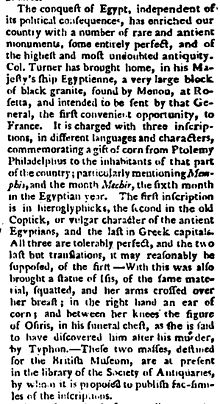 Report of the arrival of the Rosetta Stone in England in The Gentleman's Magazine, 1802
Report of the arrival of the Rosetta Stone in England in The Gentleman's Magazine, 1802
On Napoleon's 1798 campaign in Egypt, the expeditionary army was accompanied by the Commission des Sciences et des Arts, a corps of 167 technical experts (savants). On July 15, 1799, as French soldiers under the command of Colonel d'Hautpoul were strengthening the defences of Fort Julien, a couple of miles north-east of the Egyptian port city of Rashid, Lieutenant Pierre-François Bouchard spotted a slab with inscriptions on one side that the soldiers had uncovered.[36] He and d'Hautpoul saw at once that it might be important and informed general Jacques-François Menou, who happened to be at Rosetta.[A] The find was announced to Napoleon's newly founded scientific association in Cairo, the Institut d'Égypte, in a report by Commission member Michel Ange Lancret noting that it contained three inscriptions, the first in hieroglyphs and the third in Greek, and rightly suggesting that the three inscriptions would be versions of the same text. Lancret's report, dated July 19, 1799, was read to a meeting of the Institute soon after July 25. Bouchard, meanwhile, transported the stone to Cairo for examination by scholars. Napoleon himself inspected what had already begun to be called la Pierre de Rosette, the Rosetta Stone, shortly before his return to France in August 1799.[9]
The discovery was reported in Courrier de l'Égypte, the official newspaper of the French expedition, in September: the anonymous reporter expressed a hope that the stone might one day be the key to deciphering hieroglyphs.[A][9] In 1800, three of the Commission's technical experts devised ways to make copies of the texts on the stone. One of these, the printer and gifted linguist Jean-Joseph Marcel, is credited as the first to recognise that the middle text, originally guessed to be Syriac, was, in fact, written in the Egyptian demotic script, rarely used for stone inscriptions and, therefore, seldom seen by scholars at that time.[9] It was the artist and inventor Nicolas-Jacques Conté who found a way to use the stone itself as a printing block;[37] a slightly different method for reproducing the inscriptions was adopted by Antoine Galland. The prints that resulted were taken to Paris by General Charles Dugua. Scholars in Europe were now able to see the inscriptions and attempt to read them.[38]
After Napoleon's departure, French troops held off British and Ottoman attacks for a further 18 months. In March 1801, the British landed at Aboukir Bay. General Jacques-François Menou, who had been one of the first to see the stone in 1799, was now in command of the French expedition. His troops, including the Commission, marched north towards the Mediterranean coast to meet the enemy, transporting the stone along with other antiquities of all kinds. Defeated in battle, Menou and the remnant of his army retreated to Alexandria where they were surrounded and besieged, the stone now inside the city. He admitted defeat and surrendered on August 30.[39][40]
From French to British possession
After the surrender, a dispute arose over the fate of French archaeological and scientific discoveries in Egypt, including a group of artefacts, biological specimens, notes, plans and drawings collected by the members of the commission. Menou refused to hand them over, claiming that they belonged to the Institute. British General John Hely-Hutchinson refused to relieve the city until Menou gave in. Scholars Edward Daniel Clarke and William Richard Hamilton, newly arrived from England, agreed to examine the collections in Alexandria and claimed to have found many artefacts that the French had not revealed. In a letter home, Clarke said that "we found much more in their possession than was represented or imagined".[41]
When Hutchinson claimed all materials were property of the British Crown, a French scholar, Étienne Geoffroy Saint-Hilaire, said to Clarke and Hamilton that they would rather burn all their discoveries—referring ominously to the destruction of the Library of Alexandria—than turn them over. Clarke and Hamilton pleaded the French scholars' case and Hutchinson finally agreed that items such as natural history specimens would be the scholars' private property.[40][42] Menou quickly claimed the stone, too, as his private property;[43] had this been accepted, he would have been able to take it to France.[40] Equally aware of the stone's unique value, General Hutchinson rejected Menou's claim. Eventually an agreement was reached, and the transfer of the objects was incorporated into the Capitulation of Alexandria signed by representatives of the British, French and Ottoman forces.
How exactly the stone was transferred into British hands is not clear, as contemporary accounts differ. Colonel Tomkyns Hilgrove Turner, who was to escort it to England, claimed later that he had personally seized it from Menou and carried it away on a gun-carriage. In a much more detailed account, Edward Daniel Clarke stated that a French "officer and member of the Institute" had taken him, his student John Cripps, and Hamilton secretly into the back streets behind Menou's residence and revealed the stone hidden under protective carpets among Menou's baggage. According to Clarke, their informant feared that the stone might be stolen if French soldiers saw it. Hutchinson was informed at once and the stone was taken away—possibly by Turner and his gun-carriage.[44]
Turner brought the stone to England aboard the captured French frigate HMS Egyptienne, landing in Portsmouth in February 1802.[45] His orders were to present it and the other antiquities to King George III. The King, represented by the War Secretary Lord Hobart, directed that it should be placed in the British Museum. According to Turner's narrative, he urged—and Hobart agreed—that before its final deposit in the museum, the stone should be presented to scholars at the Society of Antiquaries of London, of which Turner was a member. It was first seen and discussed there at a meeting on March 11, 1802.[B][H]
During the course of 1802, the Society created four plaster casts of the inscriptions, which were given to the universities of Oxford, Cambridge and Edinburgh and to Trinity College Dublin. Soon afterwards, prints of the inscriptions were made and circulated to European scholars.[E] Before the end of 1802, the stone was transferred to the British Museum, where it is located today.[45] New inscriptions painted in white on the left and right edges of the slab stated that it was "Captured in Egypt by the British Army in 1801" and "Presented by King George III".[2]
The stone has been exhibited almost continuously in the British Museum since June 1802.[6] During the middle of the 19th century, it was given the inventory number "EA 24", "EA" standing for "Egyptian Antiquities". It was part of a collection of ancient Egyptian monuments captured from the French expedition, including a sarcophagus of Nectanebo II (EA 10), the statue of a high priest of Amun (EA 81) and a large granite fist (EA 9).[46] The objects were soon discovered to be too heavy for the floors of Montagu House (the original building of The British Museum), and they were transferred to a new extension that was built onto the mansion. The Rosetta Stone was transferred to the sculpture gallery in 1834 shortly after Montagu House was demolished and replaced by the building that now houses the British Museum.[47] According to the museum's records, the Rosetta Stone is its most-visited single object[48] and a simple image of it has been the museum's best selling postcard for several decades.[49]
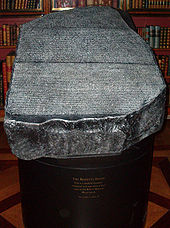 Replica of the Rosetta Stone as it was originally displayed, within the King's Library of the British Museum
Replica of the Rosetta Stone as it was originally displayed, within the King's Library of the British Museum
The Rosetta Stone was originally displayed at a slight angle from the horizontal, and rested within a metal cradle that was made for it, which involved shaving off very small portions of its sides to ensure that the cradle fitted securely.[47] It originally had no protective covering, and despite the efforts of attendants to ensure that it was not touched by visitors, by 1847 it was found necessary to place it in a protective frame.[50] Since 2004, the conserved stone has been on display in a specially built case in the centre of the Egyptian Sculpture Gallery. A replica of the Rosetta Stone as it would have appeared to early 19th-century visitors—without a case and free to touch—is now available in the King's Library of the British Museum.[51]
Toward the end of the First World War, in 1917, the museum was concerned about heavy bombing in London and moved the Rosetta Stone to safety along with other portable objects of value. The stone spent the next two years 15.24 metres (50 ft) below ground level in a station of the Postal Tube Railway at Mount Pleasant near Holborn.[6] Other than during wartime, the Rosetta Stone has left the British Museum only once: for one month in October 1972, to be displayed alongside Champollion's Lettre at the Louvre in Paris on the 150th anniversary of its publication, in October 1972.[49] Even when the Rosetta Stone was undergoing conservation measures in 1999, the work was done in the gallery so that it could remain visible to the public.[52]
Reading the Rosetta Stone
For more information, see Decipherment of Egyptian hieroglyphs.Prior to the discovery of the Rosetta Stone and its eventual decipherment, there had been no understanding of the Ancient Egyptian language and script since shortly before the fall of the Roman Empire. The usage of the hieroglyphic script had become increasingly specialised even in the later Pharaonic period; by the 4th century AD, few Egyptians were capable of reading hieroglyphs. Monumental use of hieroglyphs ceased after the closing of all non-Christian temples in the year 391 by the Roman Emperor Theodosius I; the last known inscription, found at Philae and known as The Graffito of Esmet-Akhom, is dated to 24 August 396 AD.[53]
Hieroglyphs retained their pictorial appearance and classical authors emphasised this aspect, in sharp contrast to the Greek and Roman alphabets. For example, in the 5th century the priest Horapollo wrote Hieroglyphica, an explanation of almost 200 glyphs. Believed to be authoritative yet in many ways misleading, this and other works were a lasting impediment to the understanding of Egyptian writing.[54] Later attempts at deciphering hieroglyphs were made by Arab historians in medieval Egypt during the 9th and 10th centuries. Dhul-Nun al-Misri and Ibn Wahshiyya were the first historians to study this ancient script, by relating them to the contemporary Coptic language used by Coptic priests in their time.[55][56] The study of hieroglyphs continued with fruitless attempts at decipherment by European scholars, notably Johannes Goropius Becanus in the 16th century, Athanasius Kircher in the 17th and Georg Zoëga in the 18th.[57] The discovery of the Rosetta Stone in 1799 would provide critical missing information, gradually revealed by a succession of scholars, that eventually allowed Jean-François Champollion to determine the nature of this mysterious script.
Greek text
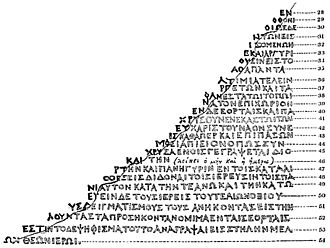 Richard Porson's suggested reconstruction of the missing Greek text (1803)
Richard Porson's suggested reconstruction of the missing Greek text (1803)
The Greek text on the Rosetta Stone provided the starting point. Ancient Greek was widely known to scholars, but the details of its use in the Hellenistic period as a government language in Ptolemaic Egypt were not familiar: large scale discoveries of Greek papyri were a long way in the future. Thus the earliest translations of the Greek text of the stone show the translators still struggling with the historical context and with administrative and religious jargon. Stephen Weston verbally presented an English translation of the Greek text at a Society of Antiquaries meeting in April 1802.[35][58] Meanwhile, two of the lithographic copies made in Egypt had reached the Institut de France in Paris, in 1801. There, the librarian and antiquarian Gabriel de La Porte du Theil set to work on a translation of the Greek. Almost immediately dispatched elsewhere on Napoleon's orders, he left his unfinished work in the hands of a colleague, Hubert-Pascal Ameilhon, who in 1803 produced the first published translations of the Greek text, in both Latin and French to ensure that they would circulate widely.[F] At Cambridge, Richard Porson worked on the missing lower right corner of the Greek text. He produced a skillful suggested reconstruction, which was soon being circulated by the Society of Antiquaries alongside its prints of the inscription. At Göttingen at almost the same moment, the Classical historian Christian Gottlob Heyne, working from one of these prints, made a new Latin translation of the Greek text that was more reliable than Ameilhon's. First published in 1803,[G] it was reprinted by the Society of Antiquaries, alongside Weston's previously unpublished English translation, Colonel Turner's narrative, and other documents, in a special issue of its journal Archaeologia in 1811.[H][59][60]
Demotic text
At the time of the stone's discovery, the Swedish diplomat and scholar Johan David Åkerblad was working on a little-known script of which some examples had recently been found in Egypt, which came to be known as Demotic. He called it "cursive Coptic" because, although it had few similarities with the later Coptic script, he was convinced that it was used to record some form of the Coptic language (the direct descendant of Ancient Egyptian). The French Orientalist Antoine-Isaac Silvestre de Sacy, who had been discussing this work with Åkerblad, received in 1801 from Jean-Antoine Chaptal, French minister of the interior, one of the early lithographic prints of the Rosetta Stone, and realised that the middle text was in this same script. He and Åkerblad set to work, both focusing on the middle text and assuming that the script was alphabetic. They attempted, by comparison with the Greek, to identify within this unknown text the points where Greek names ought to occur. In 1802, Silvestre de Sacy reported to Chaptal that he had successfully identified five names ("Alexandros", "Alexandreia", "Ptolemaios", "Arsinoe" and Ptolemy's title "Epiphanes"),[C] while Åkerblad published an alphabet of 29 letters (more than half of which were correct) that he had identified from the Greek names in the demotic text.[D][35] They could not, however, identify the remaining characters in the Demotic text, which, as is now known, included ideographic and other symbols alongside the phonetic ones.[61]
Hieroglyphic text
Silvestre de Sacy eventually gave up work on the stone, but he was to make another contribution. In 1811, prompted by discussions with a Chinese student about Chinese script, Silvestre de Sacy considered a suggestion made by Georg Zoëga in 1797 that the foreign names in Egyptian hieroglyphic inscriptions might be written phonetically; he also recalled that as long ago as 1761, Jean-Jacques Barthélemy had suggested that the characters enclosed in cartouches in hieroglyphic inscriptions were proper names. Thus, when Thomas Young, foreign secretary of the Royal Society of London, wrote to him about the stone in 1814, Silvestre de Sacy suggested in reply that in attempting to read the hieroglyphic text, Young might look for cartouches that ought to contain Greek names and try to identify phonetic characters in them.[62]
Young did so, with two results that together paved the way for the final decipherment. He discovered in the hieroglyphic text the phonetic characters "p t o l m e s" (in today's transliteration "p t w l m y s"), that were used to write the Greek name "Ptolemaios". He also noticed that these characters resembled the equivalent ones in the Demotic script, and went on to note as many as 80 similarities between the hieroglyphic and demotic texts on the stone, an important discovery because the two scripts were previously thought to be entirely different from one another. This led him to deduce correctly that the demotic script was only partly phonetic, also consisting of ideographic characters imitated from hieroglyphs.[I] Young's new insights were prominent in the long article "Egypt" that he contributed to the Encyclopædia Britannica in 1819.[J] He could, however, get no further.[63]
In 1814, Young first exchanged correspondence about the stone with Jean-François Champollion, a teacher at Grenoble who had produced a scholarly work on ancient Egypt. Champollion, in 1822, saw copies of the brief hieroglyphic and Greek inscriptions of the Philae obelisk, on which William John Bankes had tentatively noted the names "Ptolemaios" and "Kleopatra" in both languages.[64] From this, Champollion identified the phonetic characters k l e o p a t r a (in today's transliteration q l i҆ w p ꜣ d r ꜣ .t).[65] On the basis of this and the foreign names on the Rosetta Stone, he quickly constructed an alphabet of phonetic hieroglyphic characters, which appears, printed from his hand-drawn chart, in his "Lettre à M. Dacier", addressed at the end of 1822 to Bon-Joseph Dacier, secretary of the Paris Académie des Inscriptions et Belles-Lettres and immediately published by the Académie.[K] This "Letter" marks the real breakthrough to reading Egyptian hieroglyphs, for not only the alphabet chart and the main text, but also the postscript in which Champollion notes that similar phonetic characters seemed to occur in not only Greek names but also native Egyptian names. During 1823, he confirmed this, identifying the names of pharaohs Ramesses and Thutmose written in cartouches in far older hieroglyphic inscriptions that had been copied by Bankes at Abu Simbel and sent on to Champollion by Jean-Nicolas Huyot.[M] From this point, the stories of the Rosetta Stone and the decipherment of Egyptian hieroglyphs diverge, as Champollion drew on many other texts to develop a first Ancient Egyptian grammar and a hieroglyphic dictionary, both of which were to be published after his death.[66]
Later work
Work on the stone now focused on fuller understanding of the texts and their contexts by comparing the three versions with one another. In 1824, the Classical scholar Antoine-Jean Letronne promised to prepare a new literal translation of the Greek text for Champollion's use; Champollion promised in return an analysis of all the points at which the three texts seemed to differ. Following Champollion's sudden death in 1832, his draft of this analysis could not be found, and Letronne's work stalled. At the death in 1838 of François Salvolini, Champollion's former student and assistant, this and other missing drafts were found among his papers (incidentally demonstrating that Salvolini's own publication on the stone, in 1837, was plagiarism).[O] Letronne was at last able to complete his commentary on the Greek text and his new French translation of it, which appeared in 1841.[P] During the early 1850s, two German Egyptologists, Heinrich Brugsch and Max Uhlemann, produced revised Latin translations based on the demotic and hieroglyphic texts;[Q][R] the first English translation, the work of three members of the Philomathean Society at the University of Pennsylvania, followed in 1858.[S]
The question of whether one of the three texts was the standard version from which the other two were originally translated has remained controversial. Letronne, in 1841, attempted to show that the Greek version (that of the Egyptian government under its Ptolemaic dynasty) was the original.[P] Among recent authors, John Ray has stated that "the hieroglyphs were the most important of the scripts on the stone: they were there for the gods to read, and the more learned of their priesthood".[7] Philippe Derchain and Heinz Josef Thissen have argued that all three versions were composed simultaneously, while Stephen Quirke sees in the decree "an intricate coalescence of three vital textual traditions".[67] Richard Parkinson points out that the hieroglyphic version, straying from archaic formalism, occasionally lapses into language closer to that of the demotic register that the priests more commonly used in everyday life.[23] The fact that the three versions cannot be matched word for word helps to explain why its decipherment has been more difficult than originally expected, especially for those original scholars who were expecting an exact bilingual key to Egyptian hieroglyphs.[68]
Rivalries
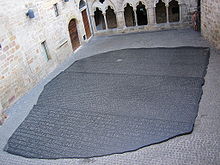 A giant copy of the Rosetta Stone by Joseph Kosuth in Figeac, France, the birthplace of Jean-François Champollion
A giant copy of the Rosetta Stone by Joseph Kosuth in Figeac, France, the birthplace of Jean-François Champollion
Even before the Salvolini affair, disputes over precedence and plagiarism punctuated the decipherment story. Thomas Young's work is acknowledged in Champollion's 1822 Lettre à M. Dacier, but incompletely, according to British critics: for example, James Browne, a sub-editor on the Encyclopædia Britannica (which had published Young's 1819 article), contributed anonymously a series of review articles to the Edinburgh Review in 1823, praising Young's work highly and alleging that the "unscrupulous" Champollion plagiarised it.[69][70] These articles were translated into French by Julius Klaproth and published in book form in 1827.[N] Young's own 1823 publication reasserted the contribution that he had made.[L] The early deaths of Young and Champollion, in 1829 and 1832, did not put an end to these disputes; the authoritative work on the stone by the British Museum curator E. A. Wallis Budge, published in 1904, gives special emphasis to Young's contribution by contrast with Champollion's.[71] In the early 1970s, French visitors complained that the portrait of Champollion was smaller than one of Young on an adjacent information panel; English visitors complained that the opposite was true. Both portraits were in fact the same size.[49]
Requests for repatriation to Egypt
In July 2003, on the occasion of the British Museum's 250th anniversary, Egypt first requested the return of the Rosetta Stone. Zahi Hawass, the chief of Egypt's Supreme Council of Antiquities, asked that the stele be repatriated to Egypt, urging in comments to reporters: "If the British want to be remembered, if they want to restore their reputation, they should volunteer to return the Rosetta Stone because it is the icon of our Egyptian identity".[72] Two years later in Paris he repeated the proposal, listing the stone as one of several key items belonging to Egypt's cultural heritage, a list which also included the iconic bust of Nefertiti in the Egyptian Museum of Berlin; a statue of the Great Pyramid architect Hemiunu in the Roemer-und-Pelizaeus-Museum in Hildesheim, Germany; the Dendara Temple Zodiac in the Louvre in Paris; and the bust of Ankhhaf from the Museum of Fine Arts, Boston.[73] During 2005, the British Museum presented to Egypt a full-size replica of the stele. This was initially displayed in the renovated Rashid National Museum, close to the site where the stone was found.[74] By November 2005, Hawass was suggesting a three-month loan of the Rosetta Stone, while reiterating the eventual goal of a permanent return;[75] in December 2009, he proposed to drop his claim for the permanent return of the Rosetta Stone if the British Museum loaned the stone to Egypt for three months, for the opening of the Grand Egyptian Museum at Giza in 2013.[76]
As John Ray has observed, "the day may come when the stone has spent longer in the British Museum than it ever did in Rosetta."[77] There is strong opposition among national museums to the repatriation of objects of international cultural significance such as the Rosetta Stone. In response to repeated Greek requests for return of the Elgin Marbles and similar requests to other museums around the world, in 2002, over 30 of the world's leading museums — including the British Museum, the Louvre, the Pergamon Museum in Berlin and the Metropolitan Museum in New York City — issued a joint statement declaring that "objects acquired in earlier times must be viewed in the light of different sensitivities and values reflective of that earlier era" and that "museums serve not just the citizens of one nation but the people of every nation".[78]
Idiomatic use
The term Rosetta stone has been used idiomatically to represent a crucial key to the process of decryption of encoded information, especially when a small but representative sample is recognised as the clue to understanding a larger whole.[79] According to the Oxford English Dictionary, the first figurative use of the term appeared in the 1902 edition of the Encyclopedia Britannica relating to an entry on the chemical analysis of glucose.[79] An almost literal use of the phrase appears in popular fiction within H. G. Wells' 1933 novel The Shape of Things to Come, where the protagonist finds a manuscript written in shorthand that provides a key to understanding additional scattered material that is sketched out in both longhand and on typewriter.[79] Perhaps its most important and prominent usage in scientific literature was Nobel laureate Theodor W. Hänsch's reference in a 1979 Scientific American article on spectroscopy where he says that "the spectrum of the hydrogen atoms has proved to be the Rosetta stone of modern physics: once this pattern of lines had been deciphered much else could also be understood".[79]
Since then the term has been widely used in other contexts. For example, fully understanding the key set of genes to the human leucocyte antigen has been described as being "the Rosetta Stone of immunology".[80] The flowering plant Arabidopsis thaliana has been called the "Rosetta Stone of flowering time".[81] A Gamma ray burst (GRB) found in conjunction with a supernova has been called a Rosetta Stone for understanding the origin of GRBs.[82] The technique of Doppler echocardiography has been called a Rosetta Stone for clinicians trying to understand the complex process by which the left ventricle of the human heart can be filled during various forms of diastolic dysfunction.[83]
The name has also become used in various forms of translation software. Rosetta Stone is a brand of language-learning software published by Rosetta Stone Ltd., headquartered in Arlington County, Virginia, US. "Rosetta" is the name of a "lightweight dynamic translator" that enables applications compiled for PowerPC processor to run on Apple systems using an x86 processor. "Rosetta" is an online language translation tool to help localisation of software, developed and maintained by Canonical as part of the Launchpad project. Similarly, Rosetta@home is a distributed computing project for predicting (or translating) protein structures. The Rosetta Project brings language specialists and native speakers together to develop a meaningful survey and near permanent archive of 1,500 languages, intended to last from AD 2000 to 12,000. The Rosetta spacecraft is on a ten-year mission to study the comet 67P/Churyumov-Gerasimenko, in the hopes that determining its composition will reveal the origins of the Solar System.
See also
- Rosetta Stone decree
- Transliteration of Ancient Egyptian
References
Timeline of early publications about the Rosetta Stone
- ^ 1799: Courrier de l'Égypte no. 37 (2 Fructidor year 7, i.e. 1799) p. 3 Retrieved July 14, 2010 (see p. 7)
- ^ 1802: "Domestic Occurrences: March 31st, 1802" in The Gentleman's Magazine vol. 72 part 1 p. 270 Retrieved July 14, 2010
- ^ 1802: Silvestre de Sacy, Lettre au Citoyen Chaptal, Ministre de l'intérieur, Membre de l'Institut national des sciences et arts, &c: au sujet de l'inscription Égyptienne du monument trouvé à Rosette. Paris, 1802 Retrieved July 14, 2010
- ^ 1802: Johan David Åkerblad, Lettre sur l'inscription Égyptienne de Rosette: adressée au c.en Silvestre de Sacy, Professeur de langue arabe à l'École spéciale des langues orientales vivantes, &c.; Réponse du c.en Silvestre de Sacy. Paris: L'imprimerie de la République, 1802
- ^ 1803: "Has tabulas inscriptionem ... ad formam et modulum exemplaris inter spolia ex bello Aegyptiaco nuper reportati et in Museo Britannico asservati suo sumptu incidendas curavit Soc. Antiquar. Londin. A.D. MDCCCIII" in Vetusta Monumenta vol. 4 plates 5–7
- ^ 1803: Hubert-Pascal Ameilhon, Éclaircissemens sur l'inscription grecque du monument trouvé à Rosette, contenant un décret des prêtres de l'Égypte en l'honneur de Ptolémée Épiphane, le cinquième des rois Ptolémées. Paris: Institut National, 1803 Retrieved July 14, 2010
- ^ 1803: Chr. G. Heyne, "Commentatio in inscriptionem Graecam monumenti trinis insigniti titulis ex Aegypto Londinum apportati" in Commentationes Societatis Regiae Gottingensis vol. 15 (1800–1803) p. 260 ff.
- ^ a b 1811: Matthew Raper, S. Weston et al., "Rosetta stone, brought to England in 1802: Account of, by Matt. Raper; with three versions: Greek, English translation by S. Weston, Latin translation by Prof. Heyne; with notes by Porson, Taylor, Combe, Weston and Heyne" in Archaeologia vol. 16 (1810–1812) pp. 208–263
- ^ 1817: Thomas Young, "Remarks on the Ancient Egyptian Manuscripts with Translation of the Rosetta Inscription" in Archaeologia vol. 18 (1817) Retrieved July 14, 2010 (see pp. 1–15)
- ^ 1819: Thomas Young, "Egypt" in Encyclopædia Britannica, supplement vol. 4 part 1 (Edinburgh: Chambers, 1819) Retrieved July 14, 2010 (see pp. 86–195)
- ^ 1822: J.-F. Champollion, Lettre à M. Dacier relative à l'alphabet des hiéroglyphes phonétiques (Paris, 1822) At Gallica: Retrieved July 14, 2010 at French Wikisource
- ^ 1823: Thomas Young, An account of some recent discoveries in hieroglyphical literature and Egyptian antiquities: including the author's original alphabet, as extended by Mr. Champollion, with a translation of five unpublished Greek and Egyptian manuscripts (London: John Murray, 1823) Retrieved July 14, 2010
- ^ 1824: J.-F. Champollion, Précis du système hiéroglyphique des anciens Égyptiens. Paris, 1824 Online version at archive.org 2nd ed. (1828) At Gallica: Retrieved July 14, 2010
- ^ 1827: James Browne, Aperçu sur les hiéroglyphes d'Égypte et les progrès faits jusqu'à présent dans leur déchiffrement (Paris, 1827; based on a series of articles in Edinburgh Review beginning with no. 55 (February 1823) pp. 188–197) Retrieved July 14, 2010
- ^ 1837: François Salvolini, "Interprétation des hiéroglyphes: analyse de l'inscription de Rosette" in Revue des deux mondes vol. 10 (1937) At French Wikisource
- ^ a b 1841: Antoine-Jean Letronne, Inscription grecque de Rosette. Texte et traduction littérale, accompagnée d'un commentaire critique, historique et archéologique. Paris, 1840 (issued in Carolus Müllerus, ed., Fragmenta historicorum Graecorum vol. 1 (Paris: Didot, 1841)) Retrieved July 14, 2010 (see end of volume)
- ^ 1851: H. Brugsch, Inscriptio Rosettana hieroglyphica, vel, Interpretatio decreti Rosettani sacra lingua litterisque sacris veterum Aegyptiorum redactae partis ... accedunt glossarium Aegyptiaco-Coptico-Latinum atque IX tabulae lithographicae textum hieroglyphicum atque signa phonetica scripturae hieroglyphicae exhibentes. Berlin: Dümmler, 1851 Retrieved July 14, 2010
- ^ 1853: Max Uhlemann, Inscriptionis Rosettanae hieroglyphicae decretum sacerdotale. Leipzig: Libraria Dykiana, 1853 Retrieved July 14, 2010
- ^ 1858: Report of the committee appointed by the Philomathean Society of the University of Pennsylvania to translate the inscription on the Rosetta stone. Philadelphia, 1858
Notes
- ^ Bierbrier (1999) pp. 111–113
- ^ a b Parkinson et al. (1999) p. 23
- ^ Synopsis (1847) pp. 113–114
- ^ Miller et al. (2000) pp. 128–132
- ^ a b Middleton and Klemm (2003) pp. 207–208
- ^ a b c The Rosetta Stone
- ^ a b c Ray (2007) p. 3
- ^ Parkinson et al. (1999) p. 28
- ^ a b c d Parkinson et al. (1999) p. 20
- ^ Budge (1913) pp. 2–3
- ^ Budge (1894) p. 106
- ^ Budge (1894) p. 109
- ^ a b Parkinson et al. (1999) p. 26
- ^ Parkinson et al. (1999) p. 25
- ^ Clarysse and Van der Veken (1983) pp. 20–21
- ^ a b c Parkinson et al. (1999) p. 29
- ^ Shaw & Nicholson (1995) p. 247
- ^ Tyldesley (2006) p. 194
- ^ a b Clayton (2006) p. 211
- ^ Bevan (1927) pp. 252–262
- ^ Assmann (2003) p. 376
- ^ Kitchen (1970) p. 59
- ^ a b Parkinson (2005) p. 13
- ^ a b Bevan (1927) pp. 264–265
- ^ Ray (2007) p. 136
- ^ Parkinson et al. (1999) p. 30
- ^ Shaw (2000) p. 407
- ^ Walker and Higgs (editors, 2001) p. 19
- ^ Bagnall and Derow (2004) (no. 137 in online version)
- ^ Simpson (n. d.); revised version of Simpson (1996) pp. 258–271
- ^ a b Bevan (1927) pp. 263–268
- ^ Parkinson (2005) p. 14
- ^ Parkinson (2005) p. 17
- ^ a b c Parkinson (2005) p. 20
- ^ a b c Budge (1913) p. 1
- ^ Benjamin, Don C. (2009-03). Stones and stories: an introduction to archaeology and the Bible. Fortress Press. p. 33. ISBN 9780800623579. http://books.google.com/books?id=OBcG8phWFMYC&pg=PA33. Retrieved 14 July 2011.
- ^ Adkins (2000) p. 38
- ^ Gillispie (1987) pp. 1–38
- ^ Wilson (1803) vol. 2 pp. 274–284
- ^ a b c Parkinson et al. (1999) p. 21
- ^ Burleigh (2007) p. 212
- ^ Burleigh (2007) p. 214
- ^ Budge (1913) p. 2
- ^ Parkinson et al. (1999) pp. 21–22
- ^ a b Andrews (1985) p. 12
- ^ Parkinson (2005) pp. 30–31
- ^ a b Parkinson (2005) p. 31
- ^ Parkinson (2005) p. 7
- ^ a b c Parkinson (2005) p. 47
- ^ Parkinson (2005) p. 32
- ^ Parkinson (2005) p. 50
- ^ Parkinson (2005) pp. 50–51
- ^ Ray (2007) p. 11
- ^ Parkinson et al. (1999) pp. 15–16
- ^ El Daly (2005) pp. 65–75
- ^ Ray (2007) pp. 15–18
- ^ Ray (2007) pp. 20–24
- ^ Andrews (1985) p. 13
- ^ Budge (1904) pp. 27–28
- ^ Parkinson et al. (1999) p. 22
- ^ Robinson (2009) pp. 59–61
- ^ Robinson (2009) p. 61
- ^ Robinson (2009) pp. 61–64
- ^ Parkinson et al. (1999) p. 32
- ^ Budge (1913) pp. 3–6
- ^ Dewachter (1990) p. 45
- ^ Quirke and Andrews (1989) p. 10
- ^ Parkinson et al. (1999) pp. 30–31
- ^ Parkinson et al. (1999) pp. 35–38
- ^ Robinson (2009) pp. 65–68
- ^ Budge (1904) vol. 1 pp. 59–134
- ^ Edwardes and Milner (2003)
- ^ "Antiquities wish list" (2005)
- ^ "Rose of the Nile" (2005)
- ^ Huttinger (2005)
- ^ "Rosetta Stone row" (2009)
- ^ Ray (2007) p. 4
- ^ Bailey (2003)
- ^ a b c d Oxford English dictionary (1989) s.v. "Rosetta stone"
- ^ "International Team"
- ^ Simpson and Dean (2002)
- ^ Cooper (2010)
- ^ Nishimura and Tajik (1998)
Bibliography
- Adkins, Lesley; Adkins, R. A. (2000). The keys of Egypt: the obsession to decipher Egyptian hieroglyphs. HarperCollins. ISBN 9780060194390.
- Allen, Don Cameron (1960). "The predecessors of Champollion". Proceedings of the American Philosophical Society 144 (5): 527–547.
- Andrews, Carol (1985). The British Museum book of the Rosetta stone. British Museum Press. ISBN 9780872260344.
- Assmann, Jan; Jenkins, Andrew (2003). The Mind of Egypt: History and Meaning in the Time of the Pharaohs. Harvard University Press. ISBN 9780674012110. http://books.google.ca/books?id=XEMadfTi_U4C&lpg=PA376&dq=Horwennefer&pg=PP1#v=onepage&q=Horwennefer&f=false. Retrieved 2010-07-21.
- "Antiquities wish list". Al-Ahram Weekly. 2005-07-20. http://weekly.ahram.org.eg/2005/751/eg7.htm. Retrieved 2010-07-18.
- Bagnall, R. S.; Derow, P. (2004). The Hellenistic period: historical sources in translation. Blackwell. ISBN 1-4051-0133-4. http://www.columbia.edu/itc/classics/bagnall/3995/readings/b-d2-9.htm. Retrieved 2010-07-18.
- Bailey, Martin (2003-01-21). "Shifting the blame". Forbes.com. http://www.forbes.com/2003/01/21/cx_0121hot.html. Retrieved 2010-07-06.
- Bevan, E. R. (1927). The House of Ptolemy. Methuen. http://penelope.uchicago.edu/Thayer/E/Gazetteer/Places/Africa/Egypt/_Texts/BEVHOP/home.html. Retrieved 2010-07-18.
- Bierbrier, M. L. (1999). "The acquisition by the British Museum of antiquities discovered during the French invasion of Egypt". In Davies, W. V. Studies in Egyptian Antiquities. (British Museum Publications).
- Brown, V. M.; Harrell, J. A. (1998). "Aswan granite and granodiorite". Göttinger Miszellen 164: 133–137.
- Budge, E. A. Wallis (1894). The mummy: chapters on Egyptian funereal archaeology. Cambridge University Press. http://www.archive.org/details/cu31924086199548. Retrieved 2010-07-19.
- Budge, E. A. Wallis (1904). The decrees of Memphis and Canopus. Kegan Paul. ISBN 9780766148093. http://books.google.fr/books?id=oDrjJjQbpi0C. Retrieved 2010-07-18.
- Budge, E. A. Wallis (1913). The Rosetta Stone. British Museum. http://www.archive.org/details/rosettastone00budguoft. Retrieved 2010-06-12.
- Burleigh, Nina (2007). Mirage: Napoleon's scientists and the unveiling of Egypt. HarperCollins. ISBN 9780060597672.
- Clarysse, G. W.; Van der Veken, G. (1983). The eponymous priests of Ptolemaic Egypt (P. L. Bat. 24). Brill.
- Clayton, Peter A. (2006). Chronicles of the Pharaohs: the reign-by-reign record of the rulers and dynasties of Ancient Egypt. Thames & Hudson. ISBN 0-500-28628-0.
- Cooper, Keith (2010-04-14). "New Rosetta Stone for GRBs as supernovae". Astronomy Now Online. http://www.astronomynow.com/news/n1004/14GRB/. Retrieved 2010-07-04.
- Dewachter, M. (1990). Champollion: une scribe pour l'Egypte. Gallimard. ISBN 9782070531035.
- Downs, Jonathan (2008). Discovery at Rosetta: the ancient stone that unlocked the mysteries of Ancient Egypt. Skyhorse Publishing. ISBN 9781602392717.
- Edwardes, Charlotte; Milner, Catherine (2003-07-20). "Egypt demands return of the Rosetta Stone". The Daily Telegraph. http://www.telegraph.co.uk/news/worldnews/africaandindianocean/egypt/1436606/Egypt-demands-return-of-the-Rosetta-Stone.html. Retrieved 2006-10-05.
- El-Aref, Nevine (2005-11-30). "The rose of the Nile". Al-Ahram Weekly. http://weekly.ahram.org.eg/2005/770/he1.htm. Retrieved 2006-10-06.
- El Daly, Okasha (2005). Egyptology: the missing millennium: Ancient Egypt in medieval Arabic writings. UCL Press. ISBN 1844720632. http://books.google.fr/books?id=f2Viq2w08AMC. Retrieved 2010-07-20.
- Gillispie, C. C.; Dewachter, M. (1987). Monuments of Egypt: the Napoleonic edition. Princeton University Press. pp. 1–38.
- "Horwennefer". Egyptian Royal Genealogy. http://www.tyndalehouse.com/Egypt/ptolemies/horwennefer_fr.htm. Retrieved 2010-06-12.
- Huttinger, Henry (2005-07-28). "Stolen treasures: Zahi Hawass wants the Rosetta Stone back—among other things". Cairo Magazine. Archived from the original on 2005-12-01. http://web.archive.org/web/20051201070256/http://www.cairomagazine.com/?module=displaystory&story_id=1238&format=html. Retrieved 2006-10-06.
- "International team accelerates investigation of immune-related genes". The National Institute of Allergy and Infectious Diseases. 2000-09-06. Archived from the original on 2007-08-09. http://web.archive.org/web/20070809000616/http://www3.niaid.nih.gov/news/newsreleases/2000/ihwg.htm. Retrieved 2006-11-23.
- Kitchen, Kenneth A. (1970). "Two donation stelae in the Brooklyn Museum". Journal of the American Research Center in Egypt 8.
- Meyerson, Daniel (2004). The linguist and the emperor: Napoleon and Champollion's quest to decipher the Rosetta Stone. Ballantine Books. ISBN 9780345450678.
- Middleton, A.; Klemm, D. (2003). "The geology of the Rosetta Stone". Journal of Egyptian Archaeology 89: 207–216.
- Miller, E.; et al. (2000). "The examination and conservation of the Rosetta Stone at the British Museum". In Roy, A. and Smith, P. Tradition and Innovation. (British Museum Publications). pp. 128–132.
- Nicholson, P. T.; Shaw, I. (2000). Ancient Egyptian materials and technology. Cambridge University Press.
- Nishimura, Rick A.; Tajik, A. Jamil (1998-04-23). "Evaluation of diastolic filling of left ventricle in health and disease: Doppler echocardiography is the clinician's Rosetta Stone". Journal of the American College of Cardiology. http://www.sciencedirect.com/science?_ob=ArticleURL&_udi=B6T18-3SHT4PW-1G&_user=10&_coverDate=07/31/1997&_rdoc=1&_fmt=high&_orig=search&_sort=d&_docanchor=&view=c&_acct=C000050221&_version=1&_urlVersion=0&_userid=10&md5=01899803d067327985c0665055ca0ad5. Retrieved 2010-07-05.
- Oxford English dictionary. 2nd ed.. Oxford University Press. 1989. ISBN 978-0-19-861186-8. http://dictionary.oed.com/.
- Parkinson, Richard B.; Diffie, W.; Simpson, R. S. (1999). Cracking codes: the Rosetta stone and decipherment. University of California Press. ISBN 9780520223066. http://books.google.com/books?id=QD9g1mMaAAsC. Retrieved 2010-06-12.
- Parkinson, Richard B. (2005). The Rosetta Stone. British Museum objects in focus. British Museum Press. ISBN 9780714150215.
- Quirke, Stephen; Andrews, Carol (1989). The Rosetta Stone. Abrams. ISBN 9780810915725.
- Ray, J. D. (2007). The Rosetta Stone and the rebirth of Ancient Egypt. Harvard University Press. ISBN 9780674024939. http://books.google.com/books?id=TJCT5ajby2IC. Retrieved 2010-06-12.
- Robinson, Andrew (2009). Lost languages: the enigma of the world's undeciphered scripts. Thames & Hudson. ISBN 9780500514535.
- "The Rosetta Stone". The British Museum. http://www.britishmuseum.org/research/search_the_collection_database/search_object_details.aspx?objectid=117631&partid=1&searchText=rosetta+stone&fromADBC=ad&toADBC=ad&numpages=10&orig=%2fresearch%2fsearch_the_collection_database.aspx¤tPage=1. Retrieved 2010-06-12.
- "Rosetta Stone row 'would be solved by loan to Egypt'". BBC News. 2009-12-08. http://news.bbc.co.uk/2/hi/middle_east/8402640.stm. Retrieved 2010-07-14.
- Shaw, Ian (2000). The Oxford history of Ancient Egypt. Oxford University Press. ISBN 0-19-280458-8.
- Simpson, Gordon G.; Dean, Caroline (2002-04-12). "Arabidopsis, the Rosetta Stone of flowering time?". Science. http://www.sciencemag.org/cgi/content/abstract/296/5566/285?ijkey=zlwRiv/qSEivQ&keytype=ref&siteid=sci. Retrieved 2006-11-23.
- Shaw, Ian; Nicholson, Paul (1995). The Dictionary of Ancient Egypt. Harry N. Abrams. ISBN 0-8109-9096-2.
- Simpson, R. S. (1996). Demotic grammar in the Ptolemaic sacerdotal decrees. Griffith Institute. ISBN 9780900416651.
- Simpson, R. S. (n. d.). "The Rosetta Stone: translation of the demotic text". The British Museum. http://www.britishmuseum.org/explore/highlights/article_index/r/the_rosetta_stone_translation.aspx. Retrieved 2010-07-21.
- Solé, Robert; Valbelle, D. (2002). The Rosetta Stone: the story of the decoding of hieroglyphics. Four Walls Eight Windows. ISBN 9781568582269.
- Spencer, Neal; Thorne, C. (2003). Book of Egyptian hieroglyphs. British Museum Press, Barnes & Noble. ISBN 9780760741993.
- Synopsis of the Contents of the British Museum. British Museum. 1847. http://books.google.com/books?id=jHJUAAAAYAAJ&printsec=frontcover&source=gbs_ge_summary_r&cad=0#v=onepage&q&f=false.
- Tyldesley, Joyce (2006). Chronicle of the Queens of Egypt. Thames & Hudson. ISBN 0-500-05145-3.
- Walker, Susan; Higgs, Peter (editors) (2001). Cleopatra of Egypt. British Museum Press. ISBN 0-7141-1943-1.
- Wilson, Robert Thomas (1803). History of the British expedition to Egypt. 4th ed.. Military Library. http://books.google.fr/books?id=mypLAAAAYAAJ. Retrieved 2010-07-19.
External links
- Egyptian Hieroglyphs at the Open Directory Project
- The Rosetta Stone in The British Museum
- The translated text in English – The British Museum
- Champollion's alphabet – The British Museum
- How the Rosetta Stone works – Howstuffworks.com
- The 1999 conservation and restoration of The Rosetta Stone at The British Museum
This article is about an item held in the British Museum. Object reference: BM/Big number: 24.Categories:- 196 BC
- 2nd-century BC steles
- Ancient Egyptian objects in the British Museum
- Ancient Egyptian stelas
- Antiquities acquired by Napoleon
- Archaeological corpora documents
- Egyptology
- Metaphors referring to objects
- Multilingual texts
- Nile River Delta
- Ptolemaic dynasty
- Ptolemaic Greek inscriptions
- Stones
Wikimedia Foundation. 2010.

